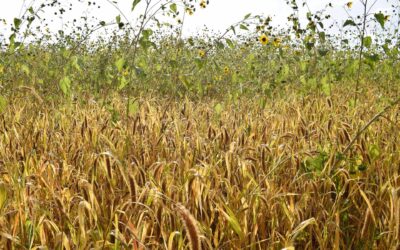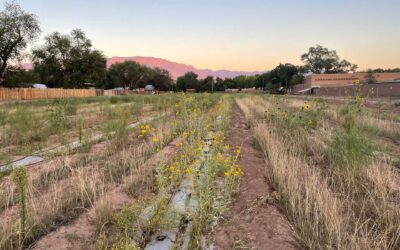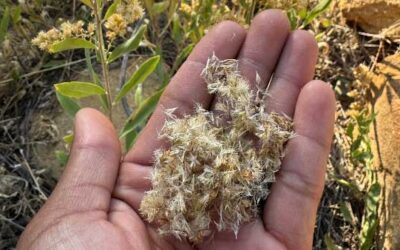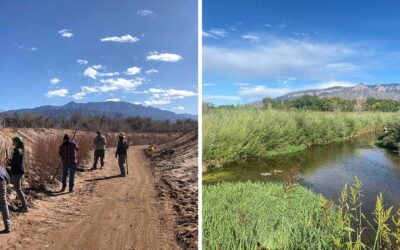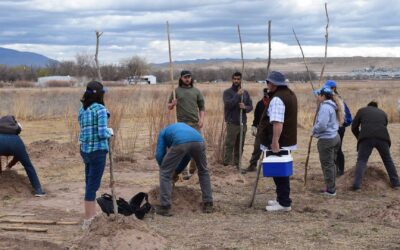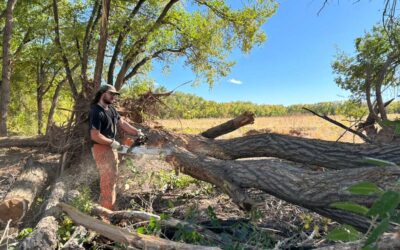Habitat Conservation
Reclaiming Land, Reviving Wildlife, Reconnecting People
Led by Cameron Weber, the Habitat Conservation Program helps to restore the ecological heartbeat of the Middle Rio Grande Valley, transforming degraded lands into vibrant, interconnected habitats that support wildlife and sustain communities. Integral to this work is a simple but powerful belief: healthy ecosystems are essential for both wildlife and people. Through a wide range of on-the-ground projects, we’re creating richly layered landscapes that provide food, shelter, and resilience.
The Habitat Conservation Program operates at the intersection of conservation, community, and regenerative land management. Initiatives include:
- Restoring open space – reviving former agricultural lands into diverse native wildlife habitat.
- Building healthy soils through strategic planting of native vegetation.
- Controlling erosion and reducing the spread of invasive plant species.
- Growing native plants and seeds for use at restoration sites.
- Harvesting wildland seed from resilient local plant populations.
- Engaging volunteers in hands-on restoration, education, and stewardship
All of this happens in urban, suburban, and rural settings, where the pressure on natural resources is high – but so is the potential for positive impact.
The Habitat Conservation Program is more than restoration – it’s a dynamic, community-responsive model of conservation. We collaborate closely with local residents, volunteers, and civic leaders to ensure local needs, ecological priorities, and long-term sustainability are reflected in our work. We believe conservation should be visible, tangible, and participatory – and that it must evolve alongside the people and places it serves.
The restored habitats of the Middle Rio Grande are often described as a “string of pearls” – precious, linked spaces that provide critical stopover habitat for migratory birds and year-round refuge for resident wildlife. Rio Grande Return has been instrumental in adding new pearls to this necklace of green. With every project, we’re helping to stitch together stronger ecological fabric that benefits wildlife, supports climate resilience, and reconnects communities with the natural world around them. As our work continues, the Habitat Conservation Program also advocates for forward-thinking policies and projects that expand this vision, ensuring that the lands we depend on will thrive for generations to come.
Habitat Conservation Projects
Candelaria Nature Preserve
Turning Historic Farmland into Habitat for the Future Rio Grande Return is working with Ciudad Soil & Water Conservation District and the City of...
Casa San Ysidro Heritage Field
The 2.38 acre Casa San Ysidro Heritage Field is dedicated to preserving agricultural heritage of the area and expanding educational programming and community involvement.
Wildland Seed Harvest
Access to locally-adapted, climate-ready seeds is very limited throughout New Mexico, so Rio Grande Return started a collaborative Wildland Seed Harvesting Program.
Harvey Jones Bioswale
Harvey Jones Bioswale before and after restoration. Restoring Wetlands, Protecting the Rio Grande The Harvey Jones Bioswale is a powerful example of how green...
Valle de Oro National Wildlife Refuge
A Model for Urban Conservation Valle de Oro National Wildlife Refuge (VdO) stands as one of the most ambitious and inspiring urban conservation projects in...
Tijeras Watershed Restoration
Bye-Bye Invasives, Hello Habitat! Rio Grande Return is helping to restore sections of Tijeras Creek and its floodplain. Over time, Tijeras Creek has become...
Stay informed
Sign up for updates
We need your support
We all have a responsibility to repair what we've broken. Our restoration and conservation work is made possible through federal, state, and private funders like you. Your donation will help us keep the lights on while supporting our field work.
